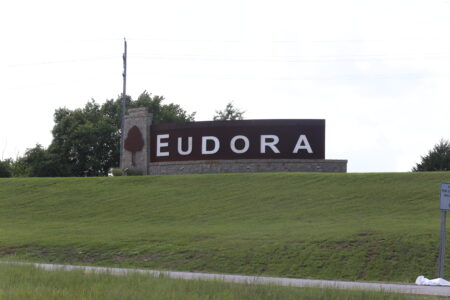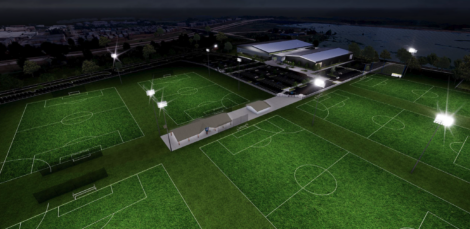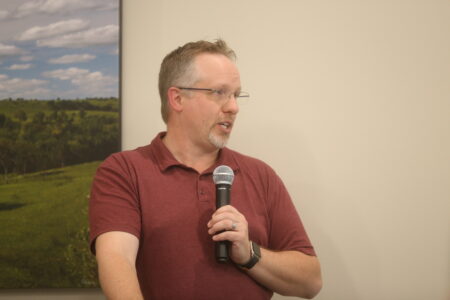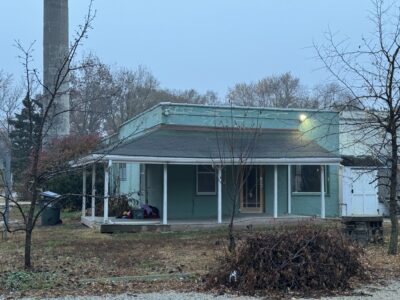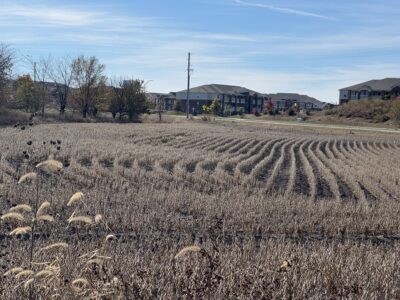
While home construction is slow in Lawrence, Baldwin City has building lots ready for 120 houses
The two towns are making different bets on growth and its payouts

photo by: Chad Lawhorn/Journal-World
A pair of construction workers build a roof on a new home under construction in Baldwin City on July 10, 2025.
On a parcel of pasture not far from where the Santa Fe Trail once stretched, Baldwin City leaders are embarking on a big adventure.
Area developers in this town of about 5,000 people in southern Douglas County have presented, and the city council has approved, a plan to convert this rolling grassland site into a new neighborhood that will have 35 big homes setting on lots of about 1 acre each.
Roads and utilities are already in place, one house is under construction, and local leaders are looking forward to the property taxes the homes — likely in the $700,000 to $1 million range — will pay. They’re also hoping the big homes will mean big families that will provide a boost to school enrollments, which are under pressure, like many others, as birthrates have been declining.
“I like to think that is going to bring a great family to our community,” Dave Hill, CEO of Baldwin-based Mid-America Bank and also the president of the town’s economic development entity, said of each mega lot and others like it.

photo by: Chad Lawhorn/Journal-World
The roads and sidewalk are in, and home construction has begun on a new Baldwin City neighborhood that features 1-acre building lots, pictured here on July 10, 2025.
So, what’s adventurous about it? Well, it is kind of like those pioneers in covered wagons crossing a raging river — there’s a strong current trying to push you a different direction.
In Lawrence, or many other communities, you probably wouldn’t have much success proposing a neighborhood full of 1-acre homesites. Professional planners tout the importance of density, density, density. There’s a worry among urban planners that traditional single family development often doesn’t produce enough new tax dollars to pay for itself over the long run — the costs of everything from maintaining the streets in front of the new homes to expanding fire departments to serve a larger population.
That’s why many planners would say a 1-acre lot should have at least four or five houses on it, or maybe even better, an apartment complex with 12 or 15 units.
Such thinking is now the norm at Lawrence City Hall, and city commissioners have approved a new development code that encourages dense development. That could be traditional apartment complexes, or it might be multi-story buildings with stores and offices on their ground floors and living units on the stories above.
As for the idea of new neighborhoods with homes built side-by-side with sidewalks in front and cul-de-sacs to congregate, Lawrence still allows them. However, the newest of those developments — which are largely still in the planning stages — propose that the majority of homes be duplexes rather than single-family houses. When single-family houses are proposed, they often are slated for lots 5,000 square feet in size, which is about 30% smaller than the traditional lot that came to define west Lawrence during its suburban heyday.
If you wanted to paint this in the extreme, your difference between Baldwin City and Lawrence could be summed up by mega homes versus duplexes. The reality is more complicated, of course. Lawrence isn’t going to be all duplexes, and mega homes will still be in the minority in Baldwin City. There currently are two other neighborhoods under development in Baldwin City, and they feature more traditional-sized homes.
It is worth noting, though, that those new Baldwin City neighborhoods will have far more single family homes than duplexes, and those single family lots — while not nearly an acre — are about 40% larger than a typical single family lot in a new Lawrence neighborhood.
In other words, there is a real difference between how Lawrence and Baldwin City are trying to build their communities — and maybe in what they believe, as well.

photo by: Chad Lawhorn/Journal-World
A Baldwin City welcome sign is pictured on July 10, 2025.
“The philosophy in Baldwin is that Baldwin City is open for business,” Hill told the Journal-World.
Hill — whose bank is the largest residential lender in Douglas County and does much business in Lawrence — didn’t specifically characterize Lawrence’s philosophy. But in a speech this week to the Baldwin City Chamber of Commerce, he did note how slow housing growth is in Lawrence, currently.
In rough numbers, Baldwin City — a community of approximately 5,000 people — hopes to sell about 30 newly-constructed single-family homes this year. Lawrence — a community of approximately 100,000 people — is on pace to build 38 single family homes this year.
Hill told the chamber crowd that Baldwin City — and its sometimes rival but similarly-sized eastern Douglas County neighbor of Eudora — have a real opportunity to attract new residents from Lawrence who are struggling to find a home that they want in Lawrence.
“I mean, they used to build 300 homes a year,” Hill said of Lawrence, pointing to numbers that were in the early 2000s or 1990s. “Now they’re doing 40 or 50. That gives you an idea of how much it is off. But it also tells you what an opportunity we have in Baldwin and Eudora to really capitalize on their inability to bring lots on the market.”

photo by: Chad Lawhorn/Journal-World
For sale signs line a new street in Baldwin City subdivision on the eastern edge of the city, pictured on July 10, 2025.
Offering incentives
Like the wagon trains that used to depart from here, there is a bit of a collective spirit at work with Baldwin’s housing efforts. In other words, developers aren’t doing this on their own.
Government is providing a large helping hand. Baldwin City currently has three new neighborhoods with approximately 120 available building lots. Each one of those neighborhoods is receiving a special property tax break.
The city is using a state program called Reinvestment Housing Incentive Districts. The districts capture nearly all of the new property tax revenues generated by the new houses constructed in the neighborhood. For up to 25 years, the property taxes those homeowners pay are rebated back to the developers of the neighborhood, who can use the proceeds to reimburse themselves for some of the development costs they incurred. That includes the price they paid for the land, plus the construction costs they paid for the streets, sidewalks, utilities and other such infrastructure items.
It is easy to see how the districts would add to the concern of planners who worry that residential growth does not generate enough new taxes to pay for itself over the long run. If the districts are capturing nearly all the new tax revenue generated by the neighborhoods, that leaves little for the city to fund the additional costs associated with serving those new homes and residents.

photo by: Chad Lawhorn/Journal-World
The foundation for a new house awaits construction on July 10, 2025 in a new Baldwin City neighborhood.
The housing incentive districts are available to be used in Lawrence — up to 100 building lots per year could be part of any such district — but the City of Lawrence has thus far not created any districts. (Lawrence has provided tax incentives to multi-family apartment projects that are part of an affordable housing program, but has not provided such incentives to single-family neighborhood developments.)
Baldwin City officials are aware of the concern that the districts will deprive the city of needed, future revenues. But many also believe in a maxim that a certain amount of growth is needed to keep a community healthy.
“They recognize that if we are not growing, our cost of living is increasing,” Baldwin City Mayor Casey Simoneau said of his fellow council members.
The districts appear poised to create growth. The 120 lots should provide three to five years worth of new homes for the community, Hill estimated. He also said he’s not sure even a fraction of those lots would be available if the incentives weren’t offered. He said he believes the incentives are the only thing that is allowing the land developers to make a profit on many of the developments.
Land developers generally make money by selling building lots to builders, who then sell a completed home to a resident. In Baldwin City, typical single family lots are selling for about $55,000 to $65,000 each. In Lawrence, single family lots are selling for about $80,000, in many instances, real estate executives and lenders told the Journal-World.
Whether Baldwin City homebuyers are seeing the benefit of those lower lot prices is not entirely clear yet. Simoneau, who also is a real estate agent, said he believes newly constructed homes are selling for less in Baldwin City than similar new homes sell for in Lawrence. But studies with reams of hard data aren’t out there yet, as the program is new in Baldwin City and the number of newly constructed homes on the Lawrence market is limited.
But, if you want to make your own comparisons, a 2400-square-foot, 4-bedroom, 3-bath home recently sold with a list price of nearly $489,000 in Baldwin City, according to advertisements. While the Lawrence market doesn’t have a lot of comparable new homes currently, one of the newly constructed Lawrence homes now advertised for sale is a 3-bedroom, 3-bath 2,300-square-foot-home with a list price of $634,000.
In reality, though, more time will be needed to see if the incentive program is consistently producing homes at lower prices than Lawrence.
Simoneau, though, said he is confident the program is going to produce more residents, who will help the economy in more ways than just paying property taxes.
“I hear quite often from residents that they want more restaurants and more shops, more of all of that stuff, and that doesn’t come without more residents here,” he said. “We have to get people who want to move here and be part of our community so the businesses that are here will be successful and will lead to more businesses here.”
Market decides
While government is getting involved in providing incentives to Baldwin City developers, it is staying out of another part of the development process. It is not trying to convince developers what size or type of houses to build.
“It kind of has been the developers that have really driven that bus,” Simoneau said of how dense new developments should be.
In Lawrence, several real estate and development leaders said the city has a firm hand on the steering wheel. That showed itself in the process to bring the Beth’s Ranch neighborhood to the market. Beth’s Ranch is at the southeast corner of Sixth and George Williams Way, and is one of the few new neighborhoods under development in the city.
When plans were first filed in 2022, the neighborhood was scheduled to have 80 single family homes. But those plans stalled in the approval process, and developers were told to look at adding more density to the project. The approved project ended up with 24 single family homes, and 82 duplex units. In other words, the density of the development increased by about 30% even though the overall acreage of the project did not grow.

photo by: Chad Lawhorn/Journal-World
Construction crews pour the foundation for a new single-family home in the Beth’s Ranch neighborhood near Sixth Street and George Williams Way on July 7, 2025.
Planners dictating density levels is nothing new in a community. Land is limited, and ensuring that a community has a sustainable development pattern is one of the primary roles of planners and local government.
But real estate and development leaders also argue that you have to take into account what buyers want to buy.
“In Baldwin City, they’re letting the developers decide what they can market,” Hill said.
In Lawrence, developers and builders have a different type of decision to make: Do they build a bunch of townhomes and hope that buyers are ready for that type of more dense living?
Chris Earl, a broker and co-owner of Stephens Real Estate, said it is still too early to know how that question will get answered. But Earl said he has seen some signs of hesitancy on the part of builders. In a town where building lots usually get bought by builders as soon as they become available, there are some duplex lots that remain unsold.
Earl said his company — which has offices in both Lawrence and Baldwin City — has had success selling duplexes — or townhomes, as the industry often calls them — in Lawrence recently. But the bulk of new townhome construction has not really begun in Lawrence, so buyer feedback has been limited.
“Townhomes may be just fine and buyers may be perfectly happy with that once they are up and ready,” Earl said. But he also noted that some townhome lots are ready for construction, but aren’t underway.
“I think maybe builders are having a little bit of pause on how confident they are that this what buyers are going to want,” Earl said.
For the community, the questions go deeper than whether duplexes ultimately will sell. There are many different types of buyers. Perhaps townhomes will be popular with younger and older buyers, but will they be bought by families with children? Lawrence is among the communities seeing flat to declining public school enrollments, which puts pressure on how many schools the community can feasibly keep open.
Ultimately, Earl thinks Lawrence is in the process of answering a couple of key questions about its evolving housing stock.
“The question is, will the market say they don’t want a brand new townhome for what it costs to have a new townhome,” Earl said. “Or, will the market say, I want brand new, and I want Lawrence, Kansas and that is what I can get here, so I’m going to buy.”
How those questions get answered, may determine a generation’s worth of growth for two towns — Lawrence and Baldwin City — that are taking diverging trails.


